I wrote this up in a Bryn Mawr alum group, but I wanted to share out here as well in case others are interested. I read a zillion online guides before creating mine, so I’ll try and link those out eventually!
I decided I wanted a wildlife pond after seeing them on some social media algorithms, so I went for it! I made one out of a half whiskey barrel (cut lengthwise, lined in PVC, on a little stand, sold to me on Etsy) and we now have some lovely critters in it.
This was its very very humble beginning:
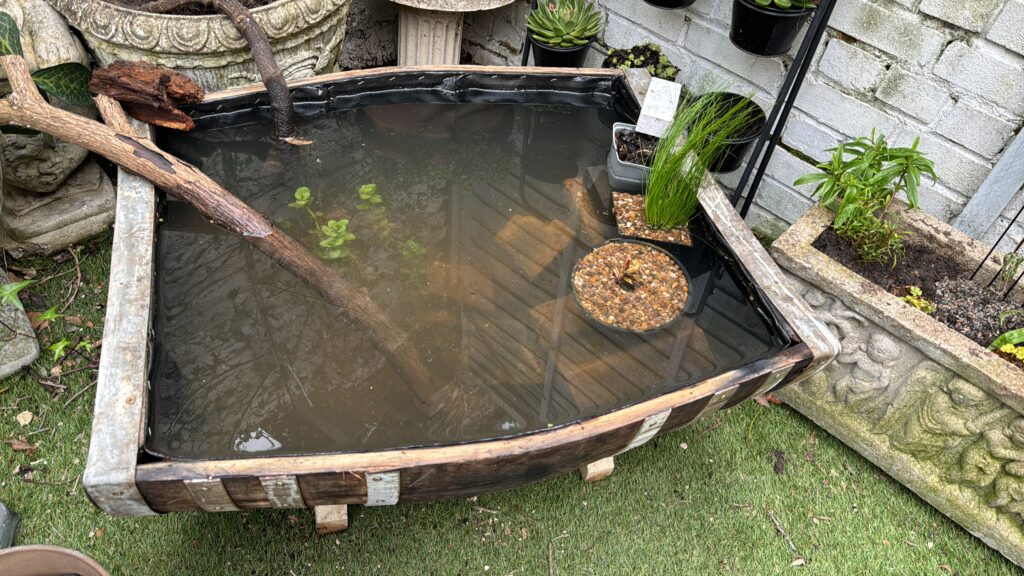
And here it is just the other day! All grown in and wild.
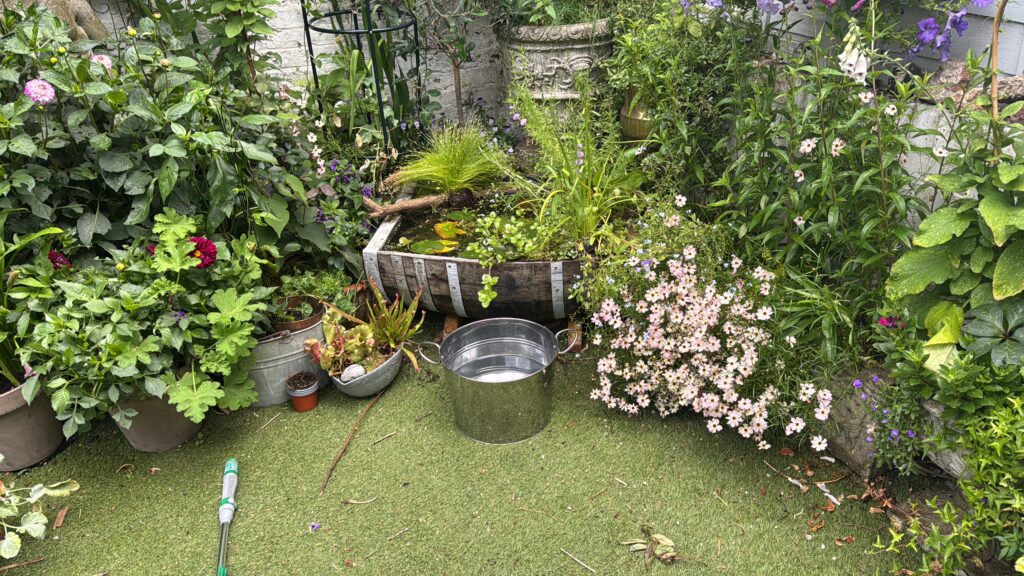
I did a TON of research before pulling this off, and because our garden is walled in with high stone walls, I also “imported” some of the wildlife (bought native species amphibian tadpoles and eggs online that we hatched as well as snails and a couple other invertebrate scavenger crawlies to keep things clean if anything died). But lots of other stuff turned up on its own, as intended! If I had more space and a lot that wasn’t all concrete, I’d have done an even better job.
Here are some key points:
Wildlife ponds are for wildlife
The aim of a wildlife pond is just that, a habitat for actual wildlife which finds it naturally. A lot of UK pond habitats have disappeared in the past few decades, which I’m sure is true in the US as well but I hear about it mostly over here. Because I knew many of the kinds of creatures that most need environmental help here couldn’t scale the walls to get in or out, I was OK buying native species eggs/young, but it’s not how one is meant to do it.
Things arrive naturally both by sensing and finding water, and by travelling on birds’ feet! Even something really tiny like a plastic tub or barrel is helpful. It’s common here to plug up an old sink, toilet, bathtub, washtub, etc to make it a pond. Kids sand pits too haha. I personally wanted something pretty, so I bought it. You just need watertight (so like not unglazed terra cotta or metal that will rust through quickly.)
Don’t worry about making it exactly like a natural pond – those form for different reasons but so many species suffer from so much habitat loss that your fake version will still be immensely beneficial. There are certainly natural pond enthusiasts who will fight me on this, but most agree that even a container vessel is beneficial as long as you make it safe.
Egress safety
You need a few key things for wildlife survival. Ideally a gently sloping gravel edge for newly hatched amphibians who don’t yet understand terrestrial living to crawl out easily (I don’t have this so I created workarounds).
If you can’t do this, have a good solid grippy textured ramp for things that fall in or need to crawl out to get out. (Not a smooth flat board – wrap it in moss and wire or something to give it texture if you can’t find a log with bark.)
Basically, clueless new froglings/toadlings and clumsy hedgehogs can drown if they can’t get out! Think like a clueless clumsy critter.
For me, I have half a rim of a curved terra cotta pot that broke, forming a sort of slope one can climb underwater to the surface. I have some floating planter “socks” from Velda with some leaves trailing into the water, a floating planter “island” (also Velda), and then a big curved branch that dips into the water and then back out again on both sides, allowing critters to figure out how to get out.
I actually watched a tiny toadling trying to figure it out last summer, and had the epiphany that with a container pond, I must must MUST always keep the water level topped up even in summer, because these critters won’t always use the easiest path and may exhaust themselves struggling against a smooth container edge. Again, think like a critter!
I have since purchased another plant “sock” to go along the back edge, which is where there was a gap between the water and the top edge because of a slight slope where it’s placed. The plant sock gives young amphibians something to grip on to and scrabble up. I’ll probably also drape the extra blanket weed I would otherwise scoop out along the front edge where the water usually meets the rim, just in case the level dips down in a drought.
Plantings
You ideally want different planting depths for 3 key types of plants – “deep water” plants like lilies (usually over 45 cm, but I have shallower and my dwarf lily is doing OK); shallow “shelves” for marginal plants that like their roots wet or damp but leaves sticking out, and then some underwater oxygenating plants (look up what’s native near you). You can optionally also have some floating plants and some “boggy” plants that don’t like their roots as wet as true marginal plants, but this is easier with a natural pond than a created one.
You can get preformed pond liners with these different depths, or you can dig a natural one, line it with the right watertight liner (have a google there as some work better than other), and create the depth with bigger rocks and gravel. Or, if you have a container, like me, you have to get creative. I used bricks in my pond and any random rocks and some not-too-sharp broken terra cotta.
You can also have sand or silt on the bottom for things to root into, but I don’t recommend putting in any actual soil, and definitely only get aquatic soils and make sure it doesn’t contain any fertiliser. (You won’t be deliberately fertilising this pond.)
You get mega wildlife bonus points for some kind of tall firm reed-like plant that supports dragonfly breeding – they lay their eggs on iris or cattail leaves, the hatchlings crawl down into the water, mature for a few years (and are FASCINATING deathly little hunters), and then crawl up the leaves, break through their exoskeleton, dry out, and fly away! I haven’t gotten to see this, partly because I didn’t put in enough reedy plants (and partly because my super urban tiny ponded space may never quite attract them). Don’t be me! Just check as some pond reed and iris plants can get both huge and kind of overzealous. I will get more for next year, but not the yellow flag iris native species or cattails that tend to take over.
There is debate over native-only pond plants vs including some non-native species. I found that, for example, the leaves of a dwarf lily provide valuable cover for critters to hide under, and our only UK native species is way too big and deep-water-needing for my itty bitty pond. So a non-invasive non-native species was fine. But I did go with mostly native stuff, and I certainly avoided anything invasive. Even some native species are too aggressive – UK water mint and the aforementioned yellow flag iris – so I sought alternatives.
Sun exposure
You usually want to place the pond itself in full or mostly full sun, but you don’t want the actual water surface to be so sunny that you get way too much algae/blanketweed, which will naturally develop with sun on water. (To a point this stuff is good as it is food and cover for little critters, but too much means that no other underwater plants get any light.) You can swirl up bunches of the stringy blanketweed type and push it to the side, but really, this is why the different kinds of plantings matter!
I’ve heard you should aim for around 60% of the pond surface, give or take, to be covered by leaves such as with your above-mentioned plants (when in full summer glory). Larger and deeper ponds can get away with more exposed surface, but my tiny one actually is doing well with even more than 60% covered; the underwater and deep water plants seem healthy still, and the blanketweed doesn’t get too excessive. It’ll be a bit of trial and error, but generally, adding more plants will help control blanketweed.
Even if you can’t place a pond in an ideal sun aspect, that shouldn’t stop you from doing it. It just means you’ll select some slightly different plantings accordingly, and you might have a bit of trial and error to find the right balance of how much of your pond’s surface to cover. You may also choose to use something like a small bale of barley straw to help control blanketweed – it apparently decomposes and gives off chemicals that help control the growth.
Water
Ideally you let a wildlife pond fill with rainwater, but you can also use tap water in some circumstances. It’s nicest to de-chlorinate it with a solution you can get at fish pet stores or online (chlorine evaporates in a few days, but chloramides and some other tap water chemicals don’t, and they can harm amphibians). I got some water conditioner on Amazon after it got too annoying to steal from my neighbours’ rain barrel (with permission) because in the summer I was doing it nearly daily.
Creatures
You might attract forms of wildlife that you’d rather avoid! We get foxes sometimes, more now than we used to, and we had a rat visit shortly after installing the pond. They eat frogs too. You might get raccoons in the US. Lucky folks here in the UK get hedgehogs and badgers, but they couldn’t scale our walls even if we had any near us. Technically all wildlife, but must be warned. Cats (yours or someone else’s) might also try to kill wildlife; you can try putting in a screen but that can cause other issues sometimes. Herons might come hunting! You never know.
There’s kind of an attitude that vertebrates like frogs, toads, and newts are the best, followed by dragonflies, and then other stuff. The reality is, the quickest thing you’ll probably start to see is mosquito larvae, haha. Sorry, but true! There are lots of other cool things – copepods, arthropods, rotifers, snails and worms and leeches galore, so many forms of the larvae of so many bugs, plus diving beetles, water boatmen… this will all eventually turn up. Some of it will hatch into gross or biting stuff, it’s true. But fascinating!
The vertebrates will only come naturally once there’s a balanced enough ecosystem to attract and sustain them. (That said, we also see cases of frogs spawning in like a leftover bucket or watering can, so who knows.) Ideally you want a pond with enough algae and other stuff to feed tadpoles which initially are vegetarian, and then later enough buggy and wormy stuff to feed them once they get carnivorous as their metamorphosis progresses.
Admittedly, there’s plenty of controversy about doing what I did, which is buying and hatching amphibian eggs (as well as getting some young tadpoles) from an allegedly reputable vendor that carefully separates and communicates native and non-native species in an ostensibly safe environment. The concern about this is things like ranavirus, a recent and insufficiently understood plague that can affect amphibians. The idea is that moving things from one pond or another (or one shop’s aquarium tank to your pond) can inadvertently spread disease. The place I bought stuff from seemed legit and prudent, but I’ve since heard cases against doing this, to the point where I probably wouldn’t do it again – I’d probably try to find an ill-placed clump of frogspawn in someone’s random bucket or watering can and ask if I could have that, but like, could be years!
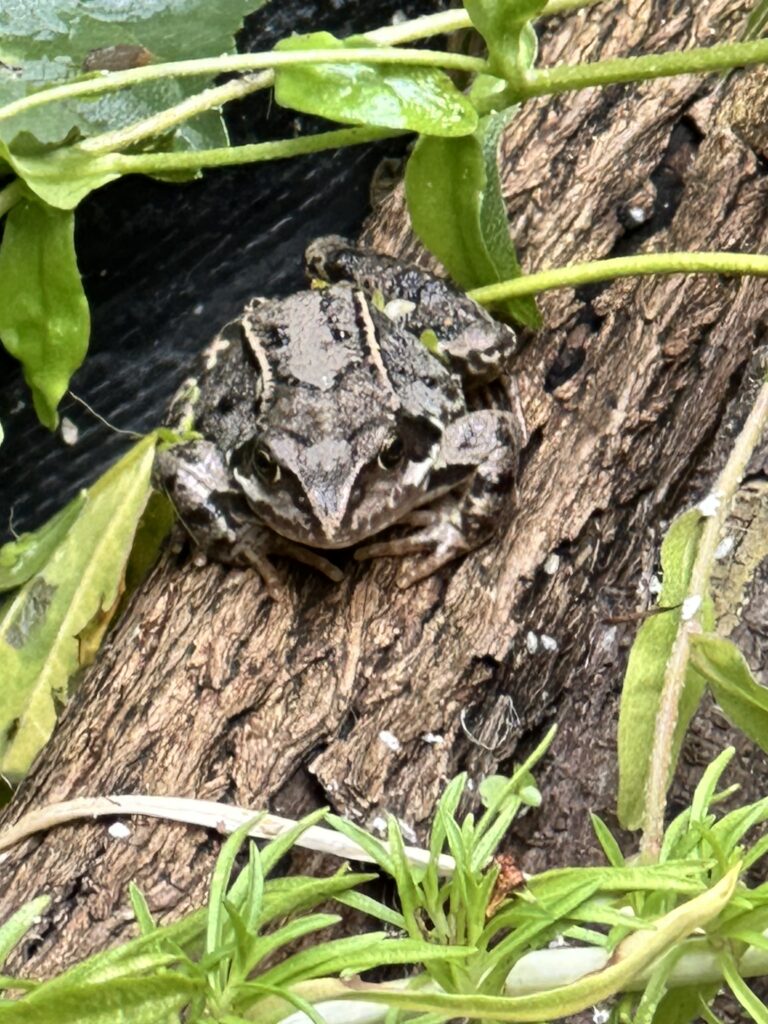
I don’t know. I feel a bit guilty now, and yet, it’s SO MAGICAL seeing the fully grown frog that now regularly chills in our pond, which I reared from a tiny thing! It was exciting when I could see the super-speedy palmate newt larvae zipping around in the pond, and I once bumped into a toad. All thrilling! For me and the kids! I hope the choice I made was a safe one, but I’m not sure I’d make it again knowing a bit more about the risks.
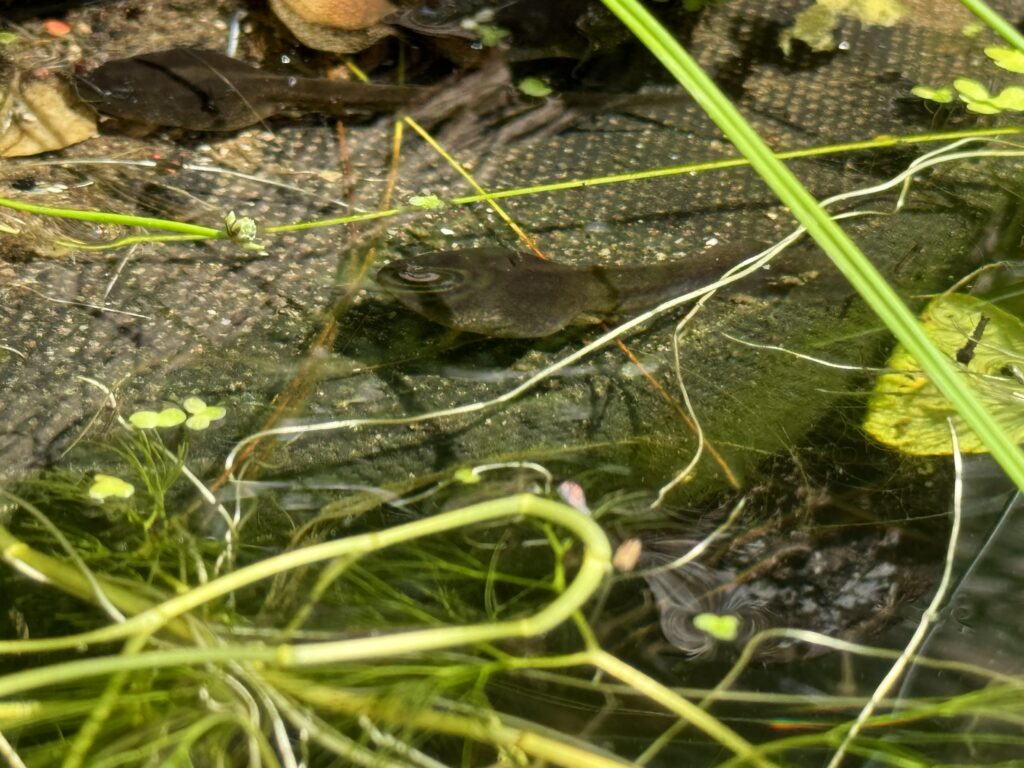

Fish
You’re not meant to artificially introduce fish into a wildlife pond. Or if you must, be careful about it. Fish tend to be predators of all the wildlife you’d be trying to support – they eat frog and toad and newt eggs and newly hatched tadpoles. They also poop and fertilise the water so much it gets gross. Fish may show up naturally as eggs sticking to birds’ feet. Up to you if you keep them there; I would in that case.
Reader, I introduced fish.
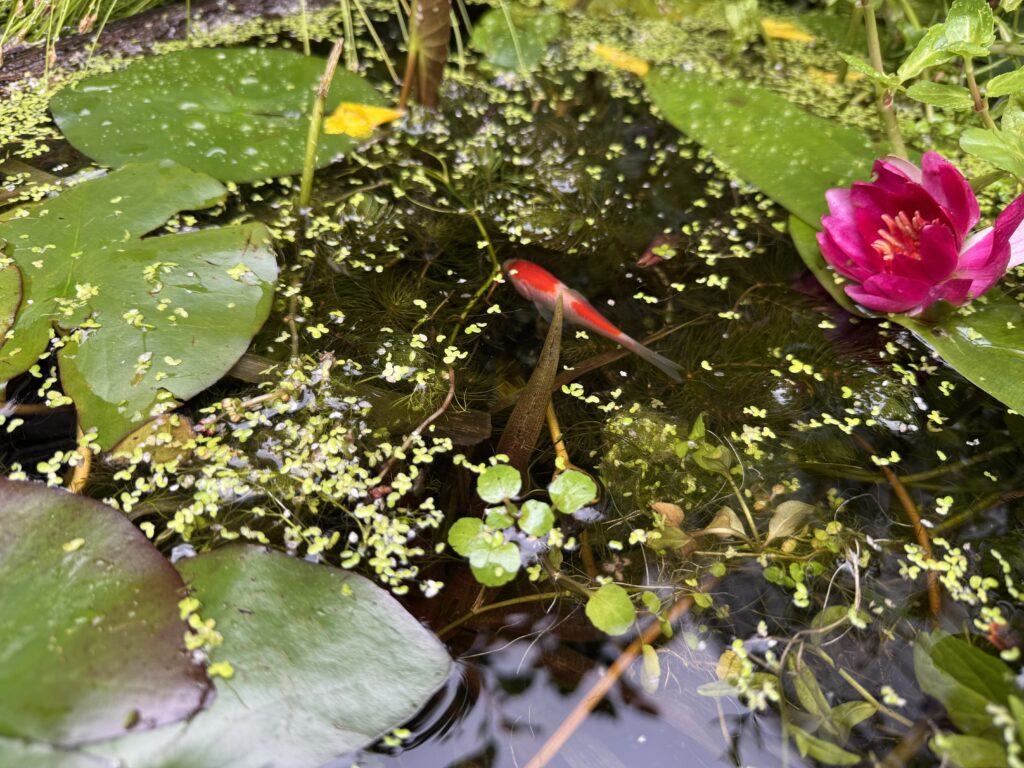
See, the mosquito larvae was still hatching into so many biting bugs, so I patiently waited until after I was sure this year’s crop of amphibians had crawled out, and got two cheap winter-hardy goldfish. The frogs and toads and newts will take at least 2 years to become sexually mature enough to spawn themselves, and I know what to look for in terms of eggs, so I’ll likely give the fishies away or put them in a different container come breeding season in a couple years. Note that this is much easier in my barrel pond than in a great big pond!
There’s an argument that I could/should have introduced a native species rather than goldfish. Here’s the thing – there are only a few tiny UK native fish species. Minnows tend to die without running water, so they were out. And the native sticklebacks… well, they are INCREDIBLY voracious predators, much more so than goldfish! So I think wildlife is actually probably safer with the non-native goldies than it would be with our native small fish species. But this is a hypothesis.
If you’re really plagued by the mosquitoes, or you live in an area with a mosquito-borne disease alert, there are sometimes chemicals you can buy that allegedly only affect mozzies and not other wildlife but idk how much to trust this.
And the thing is, if you can tough it out in the beginning, mosquito larvae and the bugs themselves are critical food sources for a lot of other nature. Dragonfly nymphs can help with this, mature older frog and toad tadpoles, more mature newt larvae, some other kinds of bugs – lots will eat the larvae. But, fish are their best predator. And for me, they love to bite me, and I’m sick of it as I have quite a strong reaction when bitten. Do with this what you will.
UPDATE: The fish were evicted. I did in fact end up with a lucky clump of otherwise foolishly placed frogspawn! WOO! Those fish were prepping to eat every last little wiggler. (I had put in some daphnia to help clear up the water when it got murky; within about one day every last one of the little water fleas had become fish food. I rehomed them into a friend’s goldfish pond. Don’t get fish.)
Aeration
In the UK wildlife pond guidance, pumps and filters are not really a thing for this kind of pond. The plants themselves should oxygenate the water enough to support life with gills etc. Filters tend to kill wildlife either physically or by destroying the ecosystem and its food sources. Pumps tend to suck tiny critters up and murder them. 😞
That said, there are creative ways you can achieve this if you want to try to move the water enough to disturb it for anti mosquito purposes, such as a wide-tube fountain that trickles in at one end and doesn’t filter the water as it gently sucks it back in through another wide tube. But you’re often better off bracing yourself for mosquitoes.
Someone in my Bryn Mawr group indicated that fish will die with only plants for oxygenation; that truly isn’t the guidance given here, so I guess we’ll find out since this will be the pond’s first winter. This alum had said that the decomposition of plants in winter sucks up a ton of the oxygen from the water. That may well be the case, but perhaps all the other plants I have in the picture will counteract the effect enough, or the goldfish will go into dormancy with the cold anyway. I’ll report back. The lion’s share of wildlife ponds here don’t have any kind of aeration and certainly no filtration, and things continue to thrive.
UPDATE: The pond did perfectly fine over the winter, no worries! The fish did too despite their unrelated eviction. Plenty of oxygenators and a mild enough winter for them to stay alive and doing their good work really helped.
So there you have it; my brain dump on wildlife ponds! Ask me if you have questions; I might not know the answer for your climate, but you can certainly try me!

